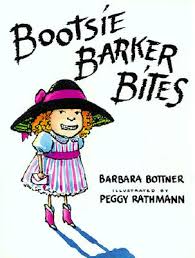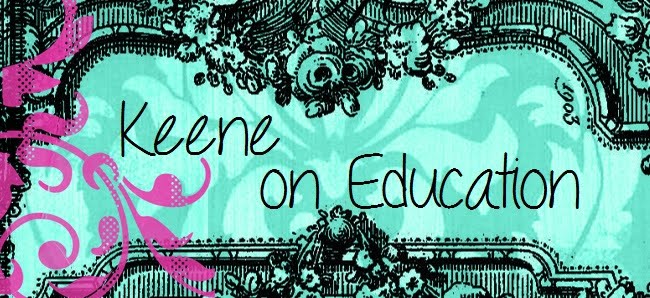Students learned that readers comprehend better when they actively
think about and apply their knowledge of a book's topic as we tapped
into our schema to read nonfiction. Now, I begin to teach students how
they can use their schema to make connections to fiction stories.
Stephanie Harvey and Anne Goudvis state, "When children understand how
to connect the text they read to their lives, they begin to make
connections between what they read and the larger world. This nudges
them into thinking about bigger, more expansive issues beyond their
universe of home, school, and neighborhood." (Strategies that Work,
2000)
So I start again by using a launching activity from
Comprehension Connections (McGregor, 2007). Around the room I hang up four picture by Norman Rockwell -
High Dive,
Day in the Life of a Boy, Day in the Life of Girl, and
Surprise.
I have students browse the pictures with a partner. I encourage
students to discuss what the pictures remind them of and leave behind a
sticky with their thoughts.
They learn the first thinking/talking stems for making connections:
- This reminds me of . . .
- I'm remembering . . .
I
explain that readers use their schema when reading fiction in lots of
way, but for this first day I only show them one way, making text to
self connections. I use a visual of paper clips joining a book and a die
cut of a person. I tell them "Connections are like chains or bridges,
they connect our schema with what we are reading. We hear our inner
voice saying, 'this reminds me of . . '
The First Connection Lesson
My first read aloud lesson on making connections comes from Stephanie Harvey's
Primary Comprehension Toolkit. As I read aloud
Patches Lost and Found By:
Steven Kroll, I model making a text to self and text to text
connections, explaining how it is helping me understand what I'm
reading. I then guide student into jotting down and drawing their
connections as I continue reading. After reading the book, I transfer my
connection to a two column think sheet. One side states "My Connection"
then other "How it helps me". I explain how I was able to understand
the character's emotions because I experienced something similar.
Students try the same as I float and confer. We then share our think
sheets.
 |
| terrible quality . . . but you get the idea |
We focus on Text to Self connections for a couple days. Each day we read a book, record our connections and discuss how it's impacting our understanding.
Snippets
The snippet lesson comes from
Strategies That Work. To avoid long drawn out stories, it uses the book
Snippets By: Charlotte Zolotow to illustrate how we can write about tiny pieces of our lives. I model choose a snippet from the text and connect it to my life, another text, or big idea. I then respond, by writing a snippet of my own. Students then choose a snippet and try to respond to it in their literacy notebooks.
Rating Our Connections Lesson
One of the earliest reads I use is,
Ira Sleeps Over
by: Bernard Waber. As we read I give students opportunites to turn and
talk about their connections. Since this is one of the first books, I
offer some scaffolding by giving the students starting points. For
example, "turn and talk about what you like to do a sleepover" or "talk
about a time when you were excited for a play date like Ira is." After
reading I have the students record one of their connections to a post-it
and collect them for the following day.
The next day we discuss the difference between a deep connection and flat connection. I introduce the students to our Meaty Connection Picture Rubric. We discuss what makes a connection a deep connection and then rate the previous days connections on the rubric. We come to the conclusion that the best connections include details and feelings.
Some books that I use for Text to Self Connections:
Once students have a good understanding of text to self connections, we begin learning about the other types of connections.
Three Types of Connections Lesson:
I begin by introducing an anchor chart and the three types of connection. I show the chain visual that they saw earlier for text to self, but this time add in the ones for text to text and text to self.
Then I begin reading
Knuffle Bunny Too By: Mo Willems. Stopping and modeling my thinking.
Stop and Talk:
- When
Trixis is excited to take her Knuffle bunny to school - “ This reminds me of my first day of 7th
grade, I was so excited to show all my friends my new outfit. It was the first
time I didn’t have to wear a uniform, I was as excited as Trixie” Explain that this a text to self connection,
the TEXT is reminding you have something that has happened to mySELF (T2S). I invite students to assemble their own text to
self puppet.
- When
Trixie has the bunny taken away - “This reminds me of Lilly’s Purple Plastic Purse. The teacher took Lily’s purse away. I remember that Lilly got it back at
the end of the day, I bet the teacher will give Trixie her bunny back at the
end of the day” Explain that is a text to text connection, one TEXT (Knuffle
Bunny Too) is reminding me of another TEXT (Lily’s purple plastic purse) (T2T).
Invite students assemble their own text to text puppet.
- When
Trixie makes her first friend in Sonja - “This reminds me of how kids often
make their first friend, it usually happens by accident because they have
something in common.” Explain this is
Text to World connection, because the TEXT is reminding of a big idea,
friendship, that happens across the WORLD (T2W). Invite students assemble their own text to world
puppet.
Now that I have modeled for the students, I relinquish some of the responsibly and guide them through determining the different types of connections. We visit blue ribbon readers website. As students watch and listen to the children on the screen make connections, they hold up their puppets to indicate which type of connection it is.
Finally, students practice this identification of different types of connections independently by listening to a song and writing their connection on post-it notes. They then stick their post-its on our chart by based on whether they made a T2S, T2T, or T2W connection. Some song suggestions: Rachel Delevoryas By: Randy Stonehill, We’re going to be friends By: White
Stripes, Popular By: Kristin Chenoweth, Old Blue By: Byrds, You’ve got a friend
in me By: Randy Newman
Text to Text Connections
The next step is taking students through story comparisons. I span each set of books over 2 to 3 days. One day we read aloud and make text to self connections, then by day 3 we are comparing the two stories making text to text connections.
Here are some book combinations:
Sometimes I'm Bombaloo and When Sophie Gets Really Really Angry

 Dooby Dooby Moo and Punk Farm
Dooby Dooby Moo and Punk Farm

 Good Boy Fergus and No David
Good Boy Fergus and No David


Ira Sleeps Over and Weekend at Wendell's


Bootsie Barker Bites and Mean Jean the Recess Queen


At the end of the unit, we discuss all we've learned about connections and why we should record them and try to connect every time we read. Here is our final anchor chart.
I also end up with a lot of work samples from my kiddos to show their understanding of making connections. Here are a look at some.
By the time we have finished this unit, students have made connections to so many characters, places, and themes. They have learned that through making connections, one can vicariously live through the pages.
"All good books are alike in that they are truer than if they had
really happened and after you are finished reading one you will feel
that all that happened to you and afterwards it all belongs to you: the
good and the bad, the ecstasy, the remorse and sorrow, the people and
the places and how the weather was." –Ernest Hemingway











